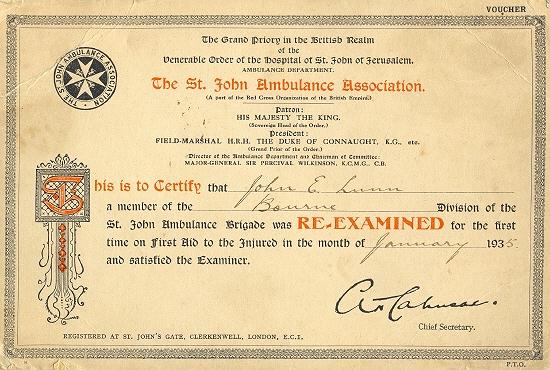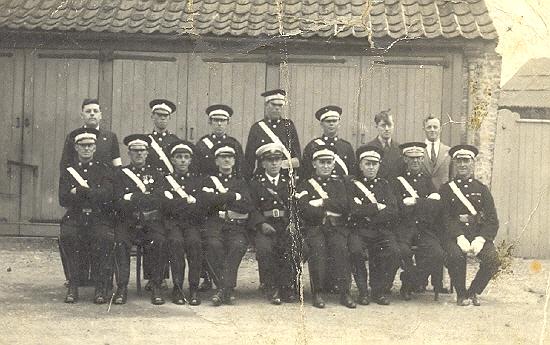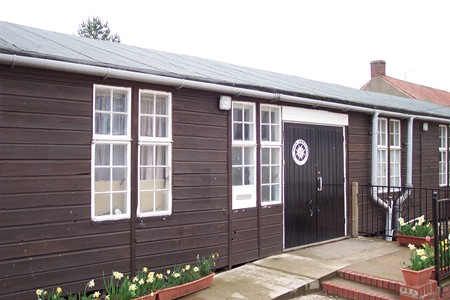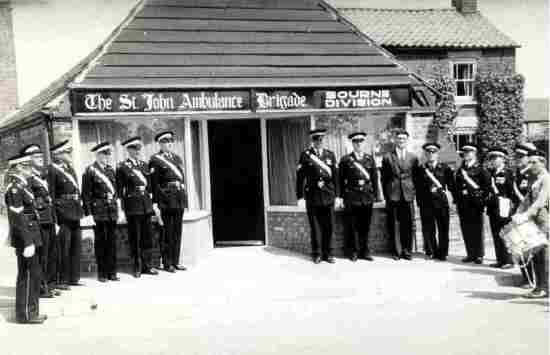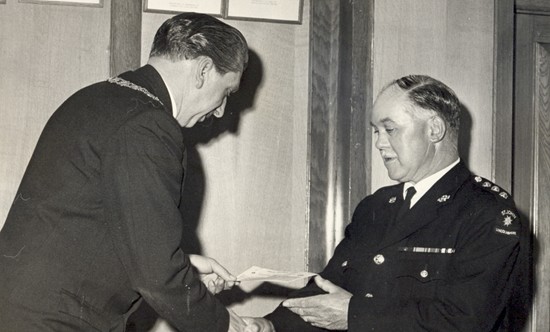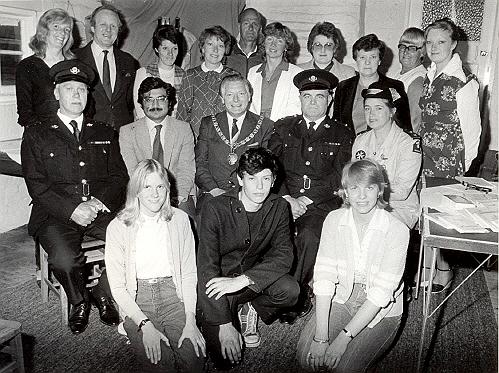One of the familiar sights at football matches and festivals are those splendidly uniformed men and women with their black tunics and white bags ready to administer first aid if anyone is taken ill. They are members of the St John Ambulance Brigade. St. John Ambulance is a charitable concern founded in 1877 that has become a modern, vigorous health care organisation with members in over 40 countries worldwide whose unpaid volunteers provide emergency first aid cover at public gatherings and sporting events. The black uniform with a white Maltese cross emblem indicates their connection with the mediaeval religious order of the Knights of St John of Jerusalem, also known as the Knights Hospitallers, founded to assist and nurse pilgrims to the Holy Land. The brigade section of the organisation began in 1888 and by 1982 numbered about 32,000 adult members and 40,000 cadets. It was famous for its outstanding work in the field during two world wars and still sends members to help in times of conflict. The Bourne division came into being as the result of a public meeting called in 1931 by general practitioner Dr John (Alistair) Galletly and Mr John Reade, manager of Lloyds Bank Ltd, to recruit support for first aid classes and to man a recently acquired ambulance that had been consigned to the town for use in emergencies. The response was so good that 40 names were handed in and the new organisation was formed with Mr H Wells as the honorary secretary. By March of that year, 30 members had passed their preliminary examinations in first aid procedures and the following officers were appointed: Divisional Superintendent, Mr Reade; Divisional Surgeon, Dr Galletly; Divisional Secretary, Mr H Wells. Mr Edgar Judge, the North Street chemist, was appointed ambulance officer in January 1932, assuming command following the resignation of Mr Reade, and was subsequently appointed Divisional Superintendent in 1934, continuing in the job until he retired in 1947 but retained a connection with the brigade as vice-president. Once qualified through the examination procedure, the men were assigned to ambulance duties when required but these did not always run smoothly. The first patient to be conveyed in the Bourne ambulance was Mr F North of Mill Drove who was placed on a stretcher which was then loaded into the back and the ambulance set off for the Butterfield Hospital, a short journey to the end of North Street, but as it was crossing the gutter, the vehicle bounced and the back doors swung open. The stretcher started to slide out of the back but one of the attendants managed to stop it before it deposited its patient in the street. Mr North recovered from the indisposition which needed the ambulance journey to hospital and never held a grudge for the mishap. In 1936, when the brigade marked its fifth anniversary, he gladly accepted an invitation to the celebration dinner and even responded to the toast to "The Visitors".
There were other embarrassing incidents and on one occasion, when the ambulance was called out to collect a man having a fit, the attendants found that a crowd of bystanders were already rendering assistance and everyone present insisted on lending a hand when he was lifted into the vehicle, some even climbing inside to put him on the stretcher. The attendant closed the doors and the ambulance sped off to hospital, taking with it half a dozen of the enthusiastic helpers. After those early days, the scope of the brigade was widened and its members became more proficient and when the ambulance service was eventually taken over by Kesteven County Council, they continued to carry out voluntary work as well as report for work as attendants when needed. They also assisted at the Butterfield Hospital and were on duty while films were being shown at the Tudor Cinema in North Street, and at all local sporting events. In 1955, home nursing was introduced as part of their studies with members attending lectures by staff from Bourne Isolation Hospital in South Road, sixteen of them obtaining certificates of proficiency in the subject.
During the Second World War of 1939-45, their training was invaluable and members manned First Aid Posts as part of the town's Civil Defence strategy and soon after the end of the war, a cadet group was formed to prepare young people for membership of the senior section when they reached the age of 16. Many boys from the town took this opportunity to learn first aid skills and one of them, Mr E Pick, rose from cadet to officer. The Bourne division celebrated its Silver Jubilee on Wednesday 25th January 1956 with a dinner at the Angel Hotel to mark their foundation 25 years before and the voluntary community service its members had completed during that time. On the night, tributes were also paid to the help that had been given by other divisions during their period of inauguration, guidance from Stamford, help with uniforms from Grimsby, and the friendly competitions in which they had all participated to keep the spirit of the brigade alive.
In recent years, the brigade continued its work in Bourne, meeting at the headquarters in a wooden hut off St Peter's Road each Monday between 8 pm and 10 pm for training in life saving and first aid skills for young people aged from 10 to 16 which were put into practice with events across the county. There were also social activities and in addition, close contact was maintained with the St John Ambulance Brigade headquarters in Lincoln. However, these activities were curtailed in 2005 due to a dwindling attendance but there was a revival in the spring of 2008 when the service was re-launched at an open evening on Tuesday April 2nd attended by the Mayor of Bourne, Councillor Jane Kingman Pauley. By this time, the brigade had a dozen adult members and were hoping to attract more together with young recruits aged 9-16 as cadets. Katrina Dawe, Divisional Superintendent for Bourne, said that the training embraced skills other than first aid, such as camping and crafts for cadets. "For adults, it is the chance to gain qualifications but it is also about having fun and meeting new people", she said. Meeting times at the St Peter's Road headquarters are now on Tuesdays from 6.30 pm until 8.30 pm for cadets and 8 pm until 10 pm for adults.
REVISED NOVEMBER 2011 See also Edgar Judge George Ernest Robinson The Butterfield Hospital
Go to: Main Index Villages Index
|
||||||||||||||||

